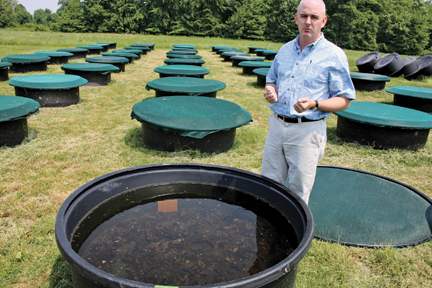Natural Resource/Last Roundup? Pitt’s Rick Relyea Studies Deadly Effects of Pesticides on Amphibians

When Pitt ecologist Rick Relyea talks about croaking frogs, he’s not referring to the rhythmic baritone sounds they make on summer nights.
Instead, Relyea is describing the worldwide annihilation of amphibian populations caused by commonly used pesticides.
The deaths of these often-overlooked animals may foreshadow the poisoning of other, less environmentally sensitive species—including humans, according to Relyea, a professor in the School of Arts and Sciences’ biological sciences department and interim director of Pitt’s Pymatuning Laboratory of Ecology (PLE).
For the last eight years, Relyea has sought to link declining frog populations with the routine use of insecticides, herbicides, and fungicides. Based on research he conducted at PLE, Relyea published papers in 2005 on four studies suggesting that the popular weed-killer Roundup® is “extremely lethal” to amphibians, and that even low doses of it can kill frogs and tadpoles alike. Roundup® manufacturer Monsanto disputes his findings.
In Relyea’s lab at the PLE’s 134-acre Farm Site, small plastic containers line the shelves; in each container are 10 tadpoles, swimming—and, in most cases, dying—in toxic soups containing concentrations of Roundup® ranging from zero (no Roundup®) to five. Level three represents the amount of Roundup® found in natural ponds sprayed directly through aerial crop dusting. Tadpoles in the level-three containers survive for only two days.
In a nearby field, Relyea’s research takes an even bleaker turn for frogkind. Relyea and his student researchers have converted 50 300-gallon circular cattle troughs into simulated ponds, full of water with Roundup® concentrations in the zero-to-three range. An extension of Relyea’s 2005 research, this experiment tests how different levels of Roundup® affect tadpoles at different stages of development.
“Most of them died the first day,” says Relyea, who is currently writing papers on his findings.
Another of Relyea’s projects suggests that the widespread spraying of the mosquito-repellent malathion—used to combat malaria and West Nile Virus—kills frogs by altering their food supply.
In a wild setting, the insecticide’s destruction can encompass an entire ecosystem. Doses too low to kill tadpoles wipe out water fleas, which feast on surface algae. The now-thriving surface algae, in turn, crowd the surface and keep nutrients from reaching the bottom-dwelling algae that tadpoles eat.
If the tadpoles don’t starve to death as a result, their development can be stunted, leaving them more vulnerable to diseases and predators as well as the normal rigors of survival.
In Relyea’s malathion study, 43 percent of adult leopard frogs in ecosystems exposed to malathion perished, even though the doses were not high enough to kill them outright.
“What doesn’t kill them directly still kills them like crazy,” Relyea observes. “It [malathion] affects them through the food web and indirectly kills half the animals.”
Furthermore, the insecticide may weaken frogs’ immune systems, particularly against a fungus called chytrid. In the late 1990s, scientists discovered the deadly infection in frog populations, many living in pesticide-sprayed areas.
“Frogs now cannot fight an infection that they could have survived decades ago,” Relyea points out.
“Traditional toxicology has it wrong on how to evaluate pesticide doses that are safe for amphibians,” he adds. While scientists have established pesticide safety standards for humans, mammals, birds, fish, and even zooplankton like water fleas, no such standards exist for the more than 6,000 species of amphibians, Relyea says.
Regulations forbid spraying most pesticides over lakes, but that doesn’t help most amphibians, which thrive in small, fish-free wetlands. Deep in a meadow along the road to Relyea’s PLE lab, a puddle might host four or five species of amphibians.
Even if a single pesticide spraying spares those puddle dwellers, poisons add up.
A recent experiment in Relyea’s lab combined 10 of the most commonly applied pesticides into a chemical cocktail. Each of the individual doses was at or below safe drinking water standards, and most killed no frogs. But, when combined, the 10-pesticide brew killed 99 percent of exposed frogs. Relyea plans to submit these results to a journal for review.
Relyea’s research makes him wonder whether amphibian deaths represent only the beginning of pesticide-related casualties, and that less sensitive creatures will eventually succumb to the increasing buildup of pesticides in the natural world.
“If amphibians are the canary in the coal mine,” Relyea says, rumbling away from the Farm Site in his truck, “we’re in trouble
Other Stories From This Issue
On the Freedom Road

Follow a group of Pitt students on the Returning to the Roots of Civil Rights bus tour, a nine-day, 2,300-mile journey crisscrossing five states.
Day 1: The Awakening
Day 2: Deep Impressions
Day 3: Music, Montgomery, and More
Day 4: Looking Back, Looking Forward
Day 5: Learning to Remember
Day 6: The Mountaintop
Day 7: Slavery and Beyond
Day 8: Lessons to Bring Home
Day 9: Final Lessons

